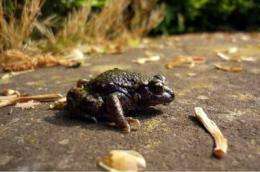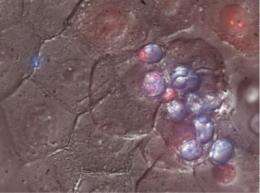Fighting massive declines in frog populations with bacteria and fungicides

A microscopic chytrid fungus is causing massive declines in frog populations all over the world and even the extinction of certain species. Together with colleagues from Europe and the USA, researchers from the University of Zurich present methods as to how the chytrid fungus can be combated in the journal Frontiers in Zoology: namely with bacteria and fungicides. However, the possibility of vaccinating the frogs is also being considered.
New pathogens are not just a growing problem for humans and livestock, but also wild animals. Along with the destruction of their habitats and the overexploitation of their populations, a disease caused by a chytrid fungus called chytridiomycosis is one of the three biggest killers of amphibians in the world.
Devastating declines in amphibian populations were observed in Australia and Central America in the 1980s and 1990s. However, it wasn't until 1998 that the pathogen, the chytrid fungus Batrachochytrium dendrobatidis, was finally identified and described; the fungus has been spreading ever since. "Whenever it has turned up somewhere new, huge numbers of frogs have died from the disease," explains Benedikt Schmidt, a conservation biologist from the University of Zurich. What supposedly started out as a tropical disease has ballooned into a global problem. Today, the fungus can be found on every continent where there are frogs.
In Europe, the chytrid fungus and substantial declines in frog populations were first recorded in the mountains of Spain. "Wherever you looked for the fungus in Europe you found it", says Schmidt. In Switzerland, the fungus was detected in about half of all the ponds sampled. Almost all the indigenous amphibian species were, albeit to varying degrees, infected with the chytrid fungus. And individual amphibians that had perished from chytridiomycosis were also discovered in Switzerland, although not to quite such an extent as the mass deaths in other countries.

While the causes of "normal" hazards for frogs are well known and it is clear how we can help the amphibians, in the case of the chytrid fungus there are no known counter-measures. Researchers from the University of Zurich therefore teamed up with colleagues from Spain, Australia and the USA to examine possible approaches to fight the fungus. "Treating individuals in a zoo, for example, is a piece of cake," says Schmidt; "fighting the fungus out in nature, however, is a different kettle of fish altogether."
Schmidt and co. see two particularly promising methods. The first involves using bacteria that live naturally on the frog's skin. Some of these skin bacteria block the chytrid fungus and can thus cure the frogs. "The approach works in the lab," explains Schmidt. "Now we need to test how the method can be used for frogs living in the wild." The second approach is simple: You catch frogs or tadpoles, treat them for the fungus and let them go again. "This also works fine in principle," says Schmidt. The only problem is how to prevent the animals from becoming reinfected as soon as you release them back into the wild.
Provided by University of Zurich














